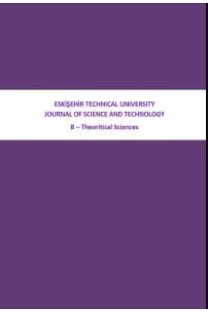ZIT DÖNEN SİLİNDİR ÇİFTİ ARASINDAKİ AKIŞ İÇİN ANALİTİK BİR YAKLAŞIM
Oto-itki, Navier-Stokes, diferansiyel geometri, parabolik koordinatlar, zıt dönen silindir çifti
AN ANALYTICAL APPROXIMATION FOR THE LOCAL FLOW BETWEEN COUNTER-ROTATING CYLINDER PAIR
self-propulsion, Navier-Stokes, Differential Geometry, Parabolic coordinates, Counter-Rotating cylinder pair,
___
- [1] Darvishyadegari,M. and Hassanzadeh,R., Convective heat transfer and fluid flow of two counter-rotating cylinders in tandem arrangement, Acta Mech, 2018; 229: 1783-1802, doi:10.1007/s00707-017-2070-6.
- [2] Gazzola, M., Mimeau, C., Tchieu,A.A. and Koumoutsakos,P., Flow mediated interactions between two cylinders at finite Re numbers, Phys. Fluids, 2012; 24: 043103, doi: 10.1063/1.4704195.
- [3] Jeffery,G.A., The Rotation of Two Circular Cylinders in a Viscous Fluid, P Roy Soc A-Math Phy, 1922; 101: 169-174, doi: 10.1098/rspa.1922.0035.
- [4] Watson,E.J., The Rotation of Two Circular Cylinders in a Viscous Fluid, Mathematika, 1995; 42: 105-126.
- [5] Watson,E.J., Slow Viscous Flow Past Two Rotating Cylinders, Q. J Mech. Appl. Math., 1996; 49: 195-216.
- [6] Ueda,Y., Sellier,A., Kida,T. and Nakanishi,M., On the Low-Reynolds-Number Flow About Two Rotating Circular Cylinders, J. Fluid Mech., 2003; 495: 255-281.
- [7] Peschard,I. and Le Gal,P., Coupled Wakes of Cylinders, Phys. Rev. Lett., 1996; 77/15: 3122-3125.
- [8] Chan,A.S. and Jameson,A., Suppression of the unsteady vortex wakes of a circular cylinder pair by a doublet-like counter-rotation, Int. J. Numer. Meth. Fluids, 2010; 63: 22-39.
- [9] Chan,A.S., Dewey,P.A., Jameson,A., Liang,C. and Smits,A.J., Vortex suppression and drag reduction in the wake of counter-rotating cylinders, J.Fluid Mech., 2011; 679: 343-382.
- [10] Yoon,H.S., Kim,J.H., Chun,H.H. and Choi,H.J., Laminar flow past two rotating circular cylinders in a side-by-side arrangement, Phys. Fluids, 2007; 19: 128103, doi: 10.1063/1.2786373.
- [11] Guo,X.H., Lin,J.Z., Tu,C.X., and Wang,H.L., Flow Past Two Rotating Circular Cylinders in a Side-By-Side Arrangement, J Hydrodyn, 2009; 21/2: 143-151, doi: 10.1016/S1001-6058(08)60131-6.
- [12] Suwannasri,P.,2013,Numerical Simulation of Self-Propelled Motion of Two Rotating Side-By-Side Circular Cylinders, SE Asian J Sci, 2013; 2/1: 19-26.
- [13] Van Rees,W.M., Novati,G., and Koumoutsakos,P., Self-propulsion of a counter-rotating cylinder pair in a viscous fluid, Phys. Fluids, 2015; 27: 063102, doi: 10.1063/1.4922314.
- ISSN: 2667-419X
- Yayın Aralığı: Yılda 2 Sayı
- Başlangıç: 2010
- Yayıncı: Eskişehir Teknik Üniversitesi
ANALYSIS OF DUST EVENT IN TURKMENISTAN AND ITS SOURCE REGIONS
WEIBULL LINDLEY DAĞILIMININ PARAMETRELERİ İÇİN FARKLI TAHMİN YÖNTEMLERİNİN KARŞILAŞTIRILMASI
ZIT DÖNEN SİLİNDİR ÇİFTİ ARASINDAKİ AKIŞ İÇİN ANALİTİK BİR YAKLAŞIM
CENTRIFUGAL PUMP DESIGN MATERIALS AND SPECIFICATIONS
Metin GÜNER, Mehmet Melih ÖZBAYER
Talha AKSOY, Özlem ERDOĞAN, Saye ÇABUK
FONKSİYONEL DERECELENDİRİLMİŞ GÖZENEKLİ KİRİŞLERİN SERBEST TİTREŞİM ANALİZİ
Vedat TAŞKIN, Pınar Aydan DEMİRHAN
